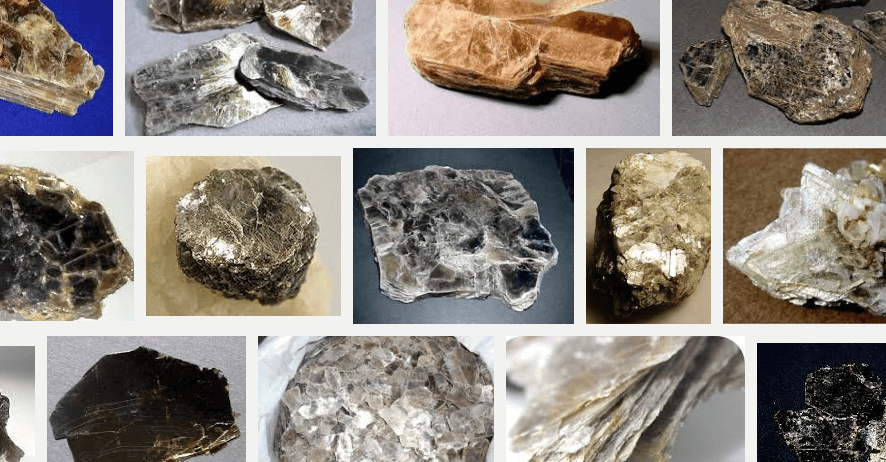Table of Contents
Mica type minerals make a group of silicates of alumina, with potash, iron, magnesia; characterized by easy cleavage into thin, flexible, elastic sheets. Mica gives off water when strongly heated.
Muscovite
Muscovite, or white mica, (K,H) AlSiO4, is colorless, sometimes gray, brown, ruby, etc.; powder, white; luster, glassy or pearly; H = 2 to 2.5; G = 2.76 to 3; crystals, usually hexagonal in appearance when well formed. This is the commonest mica, always present in mica schist, and often in granite and gneiss. The large crystals, or “books,” are useful for electric insulation, as a substitute for glass (“isinglass”), and for other purposes. Found in pegmatite granite dikes. It is stated to be inferior to amber mica (phlogopite) for electric motor and dynamo manufacture, as it wears faster and is somewhat brittle. India is the largest producer, though Quebec, Ontario, and British Columbia, and other countries produce muscovite. Value, as quoted in market reports, according to size, quality, and color. Brazil produces the finest mica for ornamental purposes.
Sericite is muscovite in fine, silky scales or fibers.
Phlogopite
Phlogopite, or amber mica, differs in composition from muscovite in that it contains about 25% to 30% magnesia; it is usually free from iron. Color, yellowish brown to brownish red, etc.; powder, white; H = 2.5 to 3; G = 2.78 to 2.85. Found in dikes of pyroxenite (a rock composed of pyroxene with more or less feldspar), particularly at their contact with gneiss, mica schist, and crystalline limestone; often along with apatite. In the best deposits, pink calcite is plentiful.
Canada has produced amber mica in comparatively large quantity; it is preferred for the manufacture of armatures of dynamos and motors, because it wears better than most commercial muscovite. For this purpose, it must be smooth, free from cracks, and from penetrating crystals of tourmaline, rutile, etc., also from stains of magnetic or hematite, which would lower the insulating power. The ordinary sizes, from 1 by 3 inches to 5 by 8 inches, bring prices of from $1.00 to $4.00 per pound, or even higher; these are the prices for mica as it leaves the cutting tables; sizes 1 x 3 and below, down to 1 x 1, are split thin and built up into micanite, or mica plate, by cementing with shellac; this can be cut and bent into any required size or shape. Scrap mica is sold for from $8.00 to $12.00 per ton, to grind for use as a lubricant, to protect the surface of roofing paper, for decorative purposes, to absorb nitroglycerine in the manufacture of dynamite, and for many other purposes.
Both white mica and amber mica are used in stove fronts, spectacles, gramophone diaphragms, fuse plugs, instead of glass in some workshops, and in lamp chimneys.
Biotite
Biotite, or black mica, has a high percentage of iron (up to about 25%), which causes its usual black color; it is also high in magnesia, and so is often called magnesia-iron mica. On account of its dark color and high percentage of iron, which lowers its insulating power, it is not often merchant-able. The powder is white or gray.
Lepidolite
Lepidolite, or Lithium mica, found with other lithium minerals in pegmatite dikes; color, rose red, lilac, yellowish, violet, gray, grayish white, white; H = 2.5 to 4; G = 2.8 to 2.9. Used to make lithium carbonate, lithium metal, lithium medicines and a very strong kind of glass. Value/ton in a concentrate containing 4% LiO2.
